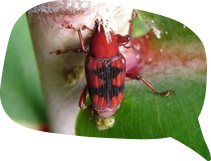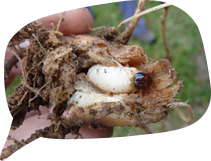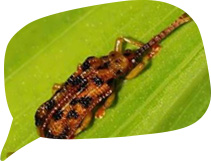Introducing the candidates...
 Stem-Mining Fly (Merochlorops dimorphus) causes shoot death, stunted plants and flower death. It takes 2-3 months to develop from an egg to larvae and has two generations a year. So far research shows that it completes its life cycle only on Wild Ginger but it is very hard to mass rear in captivity as each larvae require their own stem to develop fully.
Stem-Mining Fly (Merochlorops dimorphus) causes shoot death, stunted plants and flower death. It takes 2-3 months to develop from an egg to larvae and has two generations a year. So far research shows that it completes its life cycle only on Wild Ginger but it is very hard to mass rear in captivity as each larvae require their own stem to develop fully.

 Ginger Weevil (Prodioctes spp.) attacks all parts of the plant, with the larvae causing spectacular damage to the rhizomes (roots). This beetle feeds on all species of ginger, including our hybrid species. This is a very slow growing species with only one generation a year, so building up numbers for testing is very challenging – it needs a highly nutritious artificial diet to be developed to help speed up its growth.
Ginger Weevil (Prodioctes spp.) attacks all parts of the plant, with the larvae causing spectacular damage to the rhizomes (roots). This beetle feeds on all species of ginger, including our hybrid species. This is a very slow growing species with only one generation a year, so building up numbers for testing is very challenging – it needs a highly nutritious artificial diet to be developed to help speed up its growth.
 Bronze Spotted Hispine beetle (Gonophora pulchella), the larvae and adults feed on the leaves, causing widespread damage. These were exported to the UK for study in 2015 but their potential is unknown and requires more research.
Bronze Spotted Hispine beetle (Gonophora pulchella), the larvae and adults feed on the leaves, causing widespread damage. These were exported to the UK for study in 2015 but their potential is unknown and requires more research.
 Chaeridiona cf. pseudo metallica, another hispine beetle, known to cause damage to ginger leaves. No export permit has been granted for further study of this species. Their potential is also unknown.
Chaeridiona cf. pseudo metallica, another hispine beetle, known to cause damage to ginger leaves. No export permit has been granted for further study of this species. Their potential is also unknown.
Find out how Biocontrols have already been successful in New Zealand











